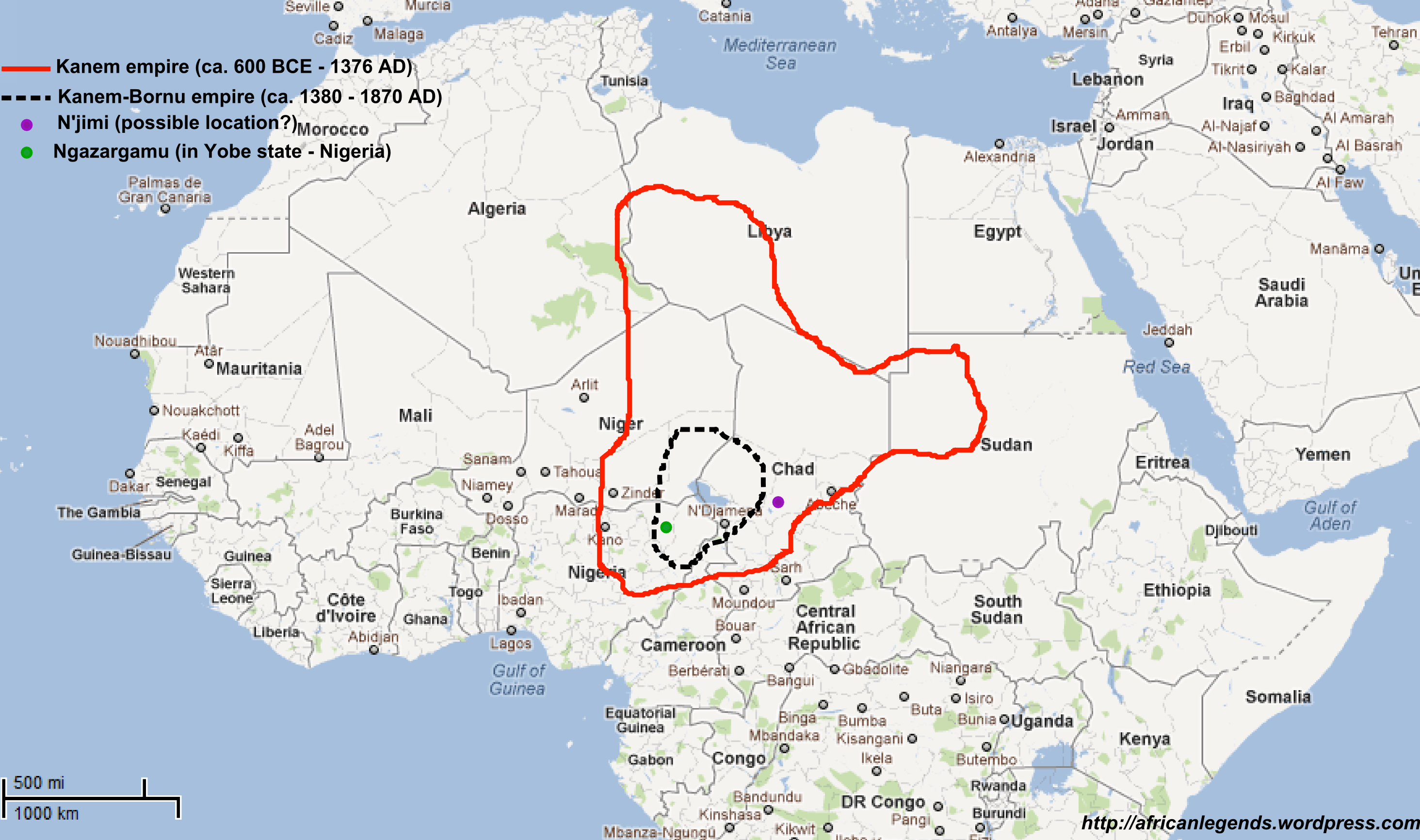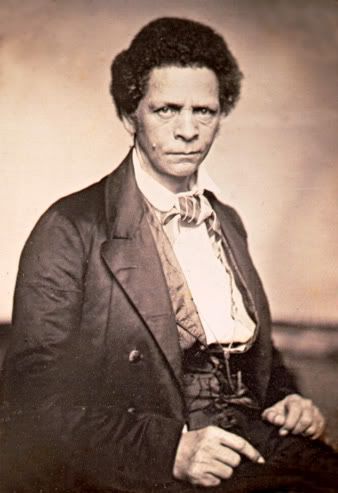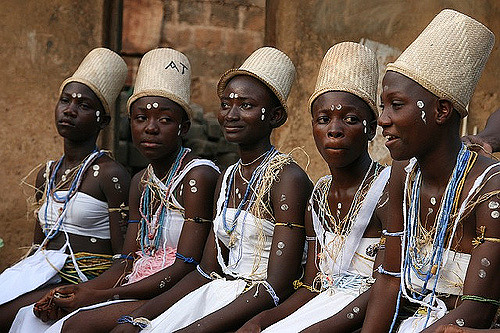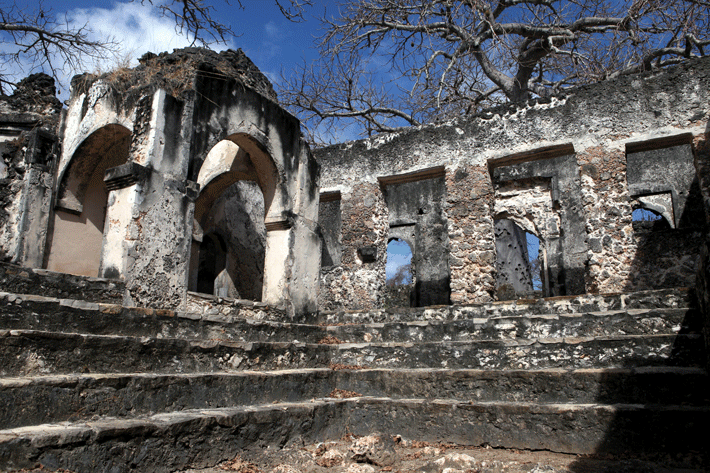The Odum of Ala Igbo
Hail Biafra!
The Peopling of West Africa (ctd)
Central Sudanic Developments

What Africa may have looked like when the Sahara was 'green'. Missing a river connecting Lake Chad to the Nile though...
Kanem and Bornu
.jpg)
Buduma woman

Kanem and Bornu Empires

Kanuri woman
Hausa States

Hausa city-states can be seen sandwiched between Borno and the Songhai Empire

Hausa man (note that all the previous images of people carried ritual scarification on their cheeks)
Towards the Forests and Coasts

Art found in Igbo-Ukwu

Bronze works discovered in Ife

Artistic depiction of the Oba of Benin meeting with European visitors
Central Sudanic Developments
- When we say 'The Central Sudan', we are referring to the region of Africa from the bend of the Niger eastward across to the Lake Chad basin and Dar Fur. It's geography is a continuation of the landscape of the Western Sudan. 4,000 years ago - it was populated by Nilo-Saharans and Afro-Asiatics. The Nilo-Saharans cultivated some crops but also had an aquatic economy based on fishing, hunting and intensive gathering. Lake Chad was a large body of water back then. But it's shrinking caused population dislocations and aided the rise of Chadic speakers, part of Afro-Asiatic dispersals across the Sahara. By 500 CE, their small, walled family compounds and villages dotted the countryside.

What Africa may have looked like when the Sahara was 'green'. Missing a river connecting Lake Chad to the Nile though...
Kanem and Bornu
- East of Lake Chad, Nilo-Saharan herders migrated southwards in search of pasture land and water for their cows. As they mixed with Chadic speakers, they become more sedentary. The prior inhabitants are called the So or Sao and easterly Chadic groups like the Kotoko, Buduma and Musgu may be their descendants. However, the nomads' culture and language prevailed.
.jpg)
Buduma woman
- The Zahgawa, ruled between Lake Chad and Dar Fur around 1000 CE, were the last in a long line of Nilo-Saharan nomads who had the eastern Lake Chad basin as their destination. The synthesis of Nilo-Saharans and Afro-Asiatics led to the formation of the Kanuri people. The founders of Kanem with its capital at Njimi. Their agricultural economy and salt mines at Bilma was the foundation of their wealth. Kanem became regularly involved in the Trans-Saharan trade around the 11th century CE. The caravans left Kanem to Fezzan on their way to Tripoli to exchange slaves for horses. Horses were needed to form cavalry contingents. Since Kanem had no gold, slaves were the priciest 'commodity' they could offer to the North Africans. Islam followed trade and soon the Kanuri populace and elite converted to Islam.
- Kanem reached its height in the mid 13th century CE, with its territory including the desert to Fezzan. Kanuri activity then shifted towards the west of Lake Chad - building a new capital at Ngazaragmu. Chadic peoples were either pushed out or absorbed. A new state, Bornu, came into being. The Kanem were conquered by the Bulala who in tern were conquered by Bornu. But, Kanuri lands east of Lake Chad had been lost, largely to Shuwa Arabs. Bornu continued with Kanuri leadership in the West for several more centuries.

Kanem and Bornu Empires

Kanuri woman
Hausa States
- The only serious rivals to the Kanuris were the Hausas. They are the largest Chadic speaking group. Hausa reached their present distribution around 1500 CE. Probably due to pressure from Bornu. Between the 13th and 14th centuries, several villages grew into cities that controlled the countryside in a radius of 50-60 km. These initial city-states were Gobir, Katsina, Zaria, Kano, Biram, Daura and Rano. These make up the 'true' seven Hausa city-states. Seven later ones are viewed as 'b*stards'.

Hausa city-states can be seen sandwiched between Borno and the Songhai Empire
- Each city had a surrounding wall, residences for the ruling family, quarters for traders and enough agricultural land to feed the population during a siege. Outside the walls were slave villages, free Hausa villages and dispersed family compounds. The city states were never united and thus, could not challenge Bornu. But, they maintained their sovereignty. All Bornu could do was exact tribute. The Hausa were also competing with the Junkun (Kwararafa) to the south and the Nupe too.
- The city states attracted non-Hausa to their walls. Fulbe, Tuareg, Kanuri, Dyula, Songhai, Arabs and North African Berbers. Most were assimilated - a Hausa cultural trait. This trait helped the Hausa expand and absorb Niger-Congo peoples. Islam also strengthened bonds, despite arriving late. But the Hausa were not fully converted to Islam at that time. A Hausa diaspora began in the 16th century CE across West africa. Hausa metal, textile and leather workers are found across the Sudan.

Hausa man (note that all the previous images of people carried ritual scarification on their cheeks)
Towards the Forests and Coasts
- 3,000 years ago, the vegetation of West Africa's rainforest was largely still intact. It was dominated by Late Stone Age gatherer-hunters. Those in the west probably spoke Atlantic languages. In the east, Ijoid...Kwa ones maybe? If agriculture occurred, it was patchy. The people of the rainforest were free from the population pressures which were driving migration in the former Green Sahara, the shrinking Lake Chad (among other lakes) and other associated phenomenon.
- We've gotten a few cultigens from the rainforest region. Okra, kola, akee and malagueta pepper. All staples are from outside the region including rice and yams. Both rice and yams may have replaced other staples. Would staples would eventually appear such as banana, cocoyams, plantains and later on maize, sweet potatoes and cassava. New foods generally increased productivity and further the advantage of farmers over hunter-gatherers.
- The tsetse fly's sleeping sickness limited the presence of cattle and goats beyond the dwarf variety. But those varities produce little meat or milk. Human and livestock diseases were barriers to settlement. Sleeping sickness had the greatest impact, though. But, agriculture and iron-making made an apperance in this region around the turn of the 1st millienium CE. The agricultural frontier advanced on 2 fronts: One being rice cultivation in the West (Atlantic and Mande) and the other being yam in the east (Kwa and Benue-Congo). The earliest settlements probably occurred in places where there was light forest cover, better drained soils and access to sea salt/fishing. The origins of the Kru, Ewe, Itsekiri, Ibibio, Efik and Ijoids probably arose among those settlements.

- Trade sped up the pace of developments. The volume of trade created long networks which helped to facilitate political centralization. Signs of these changes inclide Igbo-Ukwu (near Onitsha, Nigeria). There was a fairly settled population there by the 9th century CE. Imported goods have been found at this site. Also, local items like bronze and copper have been found despite the raw materials for these metals not being located nearby. Some items are of Mediterranean origin. Igbo-Ukwu is in the homeland of the Igbo people.

Art found in Igbo-Ukwu
- Ife is another important site. It is linked to the origins of the Yoruba. It was among the first of the Yoruba towns to have been founded between the northern margins of the forest ad the adjacent savanna. Each took advantage of north-south trade opportunities. Bronze and copper artificats have been found along with expert works in iron, wood, leather, ivory and cloth. The Yoruba expanded north and south of their strategic position in the border zone.

Bronze works discovered in Ife
- The Edo-speaking peoples founded Benin city-state around 1000 CE as they moved from the savanna into the forest region. They created high density villages after clearing forests to keep sleeping sickness at bay. Power was highly centralized within an a commercial elite class wo traded with the Hausa, Songhai, Yoruba and the fishing communities of the Niger Delta. The Benin expanded through war - typically against the Ijoid peoples.

Artistic depiction of the Oba of Benin meeting with European visitors
- Further west, Begho (now in Ghana) became a market center for the kola trade. It was controlled by a Dyula colony with links to Djenne. The political power lay with the Mossi. However, Begho seems to have been an Akan site, originally. They extended into the forest in search of kola and later gold. Proto-Akan origins along with iron age sites have been founded dating from the 11 century CE.
Last edited:
























